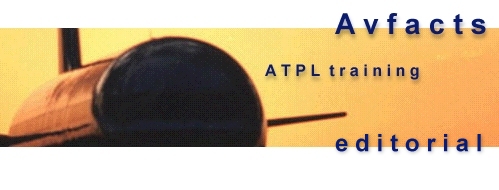




 |
 |
  |
 |
Airline Interview Technical Preparation - part 1.
|
Q1. What does "geometry
limited" mean?
Answer: Aircraft that are rather long, such as stretched versions of existing aircraft can tend to scrape their tails if the crew rotate to normal climb attitude at Vr. To counter this, the initial pitch attitude is less (B747 = 9 degrees pitch up), changing to climbout body angle of about 15 degrees once clear of ground. The flight director pitch bars give guidance on this during takeoff and initial climbout. Q2. How do wing-tip winglets work? Answer: Winglets form fences at the tip to lessen wing tip spill of high pressure air beneath wing to lower pressure above the wing. They also break down the trailing edge vortices into two smaller ones, one at winglet base, and one a tip. Two small vortices create less drag than one huge vortice, and create less of a hazard to aircraft following on approach through less induced wake turbulence. Wing tips are most effective at low speed/high alpha, where induced drag is highest, and during the earlier (and fuel hungry cruise zones) where A of A is greater than when aircraft light later in the flight. Winglets improve the range of long range aircraft such as the 747-400 more so than when fitted to short range commuter jets. Q3. Why use AVTUR and not AVGAS in jet engines? Answer: Avtur has a SG of about 0.80 kg/litre, where as avgas SG is 0.72. This means that more weight of Avtur can be fitted into a given tank volume, than can avgas. This results in more range, as primary fuel mixture to the engine combustion chamber is mixed at a rate of 15 air to 1 of fuel by weight, not volume. Hence fuel flow expressed in KG, not litres/hr. Fuels with a higher SG have a higher "calorific value", ie: they have more energy to deliver per unit of volume. Avtur is less of a fire risk (ie: high flashpoint). Down-side is greater tendency to hold water in suspension, and avtur contains residual wax content that can block fuel filters (need to heat fuel through fuel/oil heat exchangers to stop wax solidifying). Also microbial infestations are a problem. Fuel contains an anti-microbial agent to stop formation of this). Also an anti-icing agent called "Prist". Answers to questions such as these can be found in the many ATPL training texts published by Rob Avery. These are available from most pilot supply shops around Australia. Click here to view a list of these training texts. Click here to view a list of training text distributors.
|
